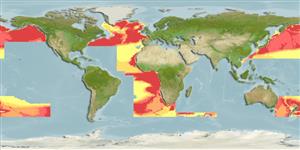>
Notacanthiformes (Halosaurs and deep-sea spiny eels) >
Notacanthidae (Deep-sea spiny eels)
Etymology: Polyacanthonotus: Greek, poly = a lot of + Greek, akantha = thorn + Greek,noton = back (Ref. 45335); challengeri: Named after the H.M.S. Challenger (Ref. 6885).
Eponymy: ‘HMS Challenger’ was a deep-sea research vessel, famous for the Challenger Expedition (1872–1876) which contributed hugely to oceanography and led to the discovery of over 4,000 previously unknown species. (Ref. 128868), visit book page.
More on author: Vaillant.
Environment: milieu / climate zone / distribuzione batimetrica / distribution range
Ecologia
marino batipelagico; distribuzione batimetrica 777 - 4560 m (Ref. 50610), usually 2000 - 3000 m (Ref. 6728). Deep-water; - 50°S
North Pacific: Japan, Bering Sea and British Columbia, Canada (Ref. 6885), also south to Oregon, USA (Ref. 35578). South Pacific: known form one specimen collected near New Zealand. Southeast Atlantic: South Africa. Southern Ocean: known from one specimen collected near the Kerguelen Islands. Mainly antitropical (Ref. 5165) but reported from Azores, Canary Islands and Morocco (Ref. 6728).
Size / Peso / Age
Maturità: Lm ? range ? - ? cm
Max length : 60.0 cm TL maschio/sesso non determinato; (Ref. )
Spine dorsali (totale) : 32 - 35; Raggi dorsali molli (totale) : 0; Vertebre: 242 - 244. Caudal fin very small; anal fin with 161-162 rays altogether, 26-35 of which are spines, long, low, confluent with caudal; pectorals with a fleshy base (Ref. 6885). Cream to faintly pink, possibly with light brown markings; black on posterior margins of anal and caudal fins; black on posterior edge of gill cover, lining of mouth and gill chamber, and parts of peritoneum (Ref. 6885).
Body shape (shape guide): eel-like.
Feeds on benthic invertebrates, especially amphipods, polychaetes and mysids (Ref. 6728).
Life cycle and mating behavior
Maturità | Riproduzione | Deposizione | Uova | Fecundity | Larve
Gon, O., 1990. Notacanthidae. p. 100-101. In O. Gon and P.C. Heemstra (eds.) Fishes of the Southern Ocean. J.L.B. Smith Institute of Ichthyology, Grahamstown, South Africa. (Ref. 5165)
IUCN Red List Status (Ref. 130435: Version 2025-1)
Threat to humans
Harmless
Human uses
Strumenti
Special reports
Download XML
Fonti Internet
Estimates based on models
Preferred temperature (Fonte Biblio.
123201): 1.5 - 3.4, mean 2.4 °C (based on 2854 cells).
Phylogenetic diversity index (Fonte Biblio.
82804): PD
50 = 0.5625 [Uniqueness, from 0.5 = low to 2.0 = high].
Bayesian length-weight: a=0.00102 (0.00046 - 0.00225), b=3.06 (2.88 - 3.24), in cm total length, based on all LWR estimates for this body shape (Ref.
93245).
Trophic level (Fonte Biblio.
69278): 3.2 ±0.42 se; based on food items.
Resilienza (Fonte Biblio.
120179): Basso, tempo minimo di raddoppiamento della popolazione 4.5 - 14 anni (Assuming tmax>10).
Fishing Vulnerability (Ref.
59153): Moderate vulnerability (44 of 100).
🛈
